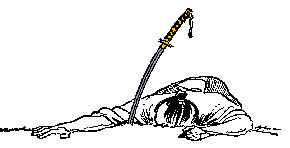History of Ju Jitsu
 Ju Jitsu has been described as "various armed and unarmed fighting systems that can be applied against armed or unarmed enemies". That's it, in a nutshell.
Ju Jitsu has been described as "various armed and unarmed fighting systems that can be applied against armed or unarmed enemies". That's it, in a nutshell.
One of the important pre-modern forms (c.1185-1600 AD) was sumai (lit. "to struggle"). The combat techniques developed from sumai were the predecessors of all Japanese empty-hand martial arts. One of these styles became yoroi kumi-uchi ("grappling in armour"). This style involved techniques by which two warriors clad in full armour could do battle if they somehow lost their weapons. As empty-hand strikes would have been ineffective against someone so protected, the system used a variety of throws and holds which would allow one to use a special dagger to kill his opponent. Of course, to the bushi, the warrior class, who never let his sword leave his side, jujutsu was the very last resort; thus it was relegated to a relatively minor position in the overall canon of techniques.
 Early schools of jujutsu, such as Takenouchi ryu, were a very eclectic group. There were at least 179 groups with names such as kogusoku, hobaku, taijutsu, wajutsu, torite, kenpo, yawara, and they dealt with small weapons and empty hand techniques, as well as swimming and horsemanship. Many schools specialised in one or two areas, such as striking, throwing, joint locking etc.
Early schools of jujutsu, such as Takenouchi ryu, were a very eclectic group. There were at least 179 groups with names such as kogusoku, hobaku, taijutsu, wajutsu, torite, kenpo, yawara, and they dealt with small weapons and empty hand techniques, as well as swimming and horsemanship. Many schools specialised in one or two areas, such as striking, throwing, joint locking etc.
With the opening of Japan by Admiral Perry in 1868, martial arts was one of the many Japanese arts that gradually became known to a few in Europe and America. The famous Yukio Tani, admittedly no master of ju jitsu, was a hit in the music hall entertainment of Victorian England. One can also imagine with delight the antics of wing-collared Victorian gentlemen being awed by the "tricks" shown to them at the Japan Society in London by Mr Barton-Wright and his Bartitsu, which included the art of fighting with a walking stick.
